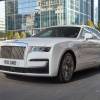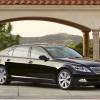
RAC sale – up to 33% off*
• Roadside cover from £5.29 a month†
• We get to most breakdowns in 60 mins or less
• Our patrols fix 4/5 breakdowns on the spot

By Jonathan Crouch
Introduction
Aware that there was a yawning gulf between the old Continental Flying Spur and the bespoke Mulsanne saloon cars, Bentley closed the gap with this more upmarket MK2 Flying Spur model which sold between 2013 and 2019. Here, we check it out as a used buy.
Models
4dr Saloon (4.0 V8 [V8, V8S] / 6.0 W12 [GT, Speed])
History
The Bentley Flying Spur. That's a Continental GT coupe with four doors and a boot. Some added legroom and an additional measure of frumpiness, right? In the past, that could indeed be the accusation, but with the launch of this MK2 generation model in 2013, Bentley introduced some key distinctions over this saloon and its Continental GT Coupe stablemate. The Continental tag was ditched and the brand went to great lengths to change the look and feel of the car as well, giving it a gravitas and presence its predecessor (launched in 2005) never fully possessed. This MK2 Flying Spur sold until the replacement third generation model was launched in the Autumn of 2019.
What You Get
Bentley's styling team worked hard to give the MK2 Flying Spur its own look and feel that was notably distinct not only from its predecessor but also from the MK2 Continental GT coupe. The shape is at the same time both more athletic in its stance and more distinguished in its detailing. Sharp feature lines complement muscular rear haunches, while LED day-time running lights, dipped headlights and tail lights complement the front and rear profiles. The interior designers created a luxurious, spacious cabin that dresses advanced acoustic and electronic technologies in exquisite hand-crafted leather hides and wood veneers. How different is it to what went before? Well, only the sun visors, grab handles, armrests and some front console and controls were carried over from the outgoing car.
The focus on improving comfort and sound isolation, especially in the rear seats, was helped by seating which can be adjusted in 14 different directions, not to mention heated and cooled. Original buyers could even specify the Flying Spur in four-seat or five-seat configurations. As you might well expect, the materials quality just cannot be faulted, although possibly with one exception. The gawky manual gear paddle shifters behind the steering wheel, one of the MK1 model's most unappealing interior features, were unaccountably retained.
What You Pay
Please fill in the form here for an exact up-to-date information.
What to Look For
The Flying Spur, like its cousin the Continental GT, is an extremely reliable car. Many of the oily bits have racked up millions of miles underneath the skin of Volkswagen's Phaeton with very little complaint and the additional tender loving care that Bentley owners lavish on their cars means that the Flying Spur is a solid used buy. Strangely, one of the few 'faults' that has been mentioned is the fact that darker coloured paint finishes can go rather 'swirly' through over-polishing!
Want some more specifics? Well the W12 engine featured in the majority of variants you'll find is a dependable unit, with no cam belts to worry about. That's a good thing, because the engine bay is pretty cramped so the engine has to come out for major work. The turbos tend not to give any problems and the spark plugs are replaced only every four years. Which is just as well because there's quite a lot of dismantling needed to get to them. The ZF six-speed auto used in the W12 is very reliable, and the few problems that have been seen are usually caused by switches and ECU connections. The variable dampers tend not to give trouble, but the front drop links for the anti-roll bar often wear, making a knocking noise. They're about £50 each to replace. The brake discs are big, to cope with the car's weight, but spirited driving can go through the front ones pretty quickly. Worn-out brakes are a good sign of a neglected car.
The tyre-pressure sensors are finished at around five years, after which the built-in battery runs out. New ones are £142 each, and by the time they're fitted, which includes removing and refitting the tyres and balancing the wheels, you could be looking at a bill of up to about £900 plus VAT. Check the car you're looking at an interview the seller to see exactly what has and hasn't been done. It's important to check that everything inside works as it should, because there are a lot of motors and electronics in there and two batteries to power them: a main one, and a smaller back-up one able to start the car in an emergency. You activate it by turning the key anti-clockwise and holding it there for 5-10sec.
Replacement Parts
(approx based on a 2014 Flying Spur W12 excl. VAT) A Pirelli P Zero Rosso tyre will cost you around £280. A pair of brake pads are about £280 for a front set and brake discs are around £580 for a front pair. An oil filter will be about £20, an air filter will be about £150, spark plugs will set you back about £160 (for a set of 12) and coil packs are priced at around £350 (again for a set of 12).
On the Road
Bentley were a little stung by criticism that the old MK1 Continental Flying Spur wasn't as refined as perhaps it could have been. There were few complaints about the W12 engine, but the amount of road, wind and suspension noise entering the cabin didn't really chime with the expected magic carpet ride. This MK2 Flying Spur set out to rectify that. A more rigid body helped Bentley's engineers to isolate and suppress vibrations and unwanted noise. Extra soundproofing, acoustic glass, a revised exhaust and improved door seals all chipped away at the decibel count. The 19-inch tyres featured more generous sidewalls to improve ride comfort and both the air suspension's compression and the anti-roll bars were a good deal softer. Corner the car harder, however and the spring stiffness increases and the driver can also choose from four suspension settings.
Under the bonnet, many original buyers preferred the renowned 6.0-litre, twin turbo W12 engine, which in the MK2 model was coupled to a ZF eight-speed transmission. Developing 552bhp in standard W12 form or 600bhp in top GT Speed guise, the MK2 Flying Spur featured more power than any other Bentley four-door in history produced before 2013. A 14 per cent improvement in the power-to-weight ratio over the outgoing model resulted in a sprint to 60mph of just 4.9 seconds in the standard version, which goes on to a top-speed of 194mph. In the modern Bentley tradition, power is delivered to the road via all-wheel drive with a 40:60 rear-biased torque split. As an alternative, buyers can choose a 4.0-litre twin-turbo V8 with 500bhp, powering the car to sixty in 4.9s en route to 183mph.
Overall
In MK2 form, the Flying Spur went some way towards shrugging off its reputation as the nearly car of the Bentley range. Previously, it always seemed to be the car you bought if your lifestyle no longer fitted the rakish Continental GT coupe but you couldn't run to a Mulsanne but with this second generation design, that changed. The MK2 model asserted its own identity far more forcefully and the styling is a good deal more confident than its predecessor.
There's an appealing mix of old school and cutting-edge technology about this 2013-2019-generation Flying Spur and although it became a more ostentatious and extrovert car than before, the market for these vehicles increasingly demands just such a personality. Some may miss the subtlety of the old MK1 Conti Flying Spur but it's a brave new world and Bentley needed here to play to the right crowd. It did - and you might like the result.







